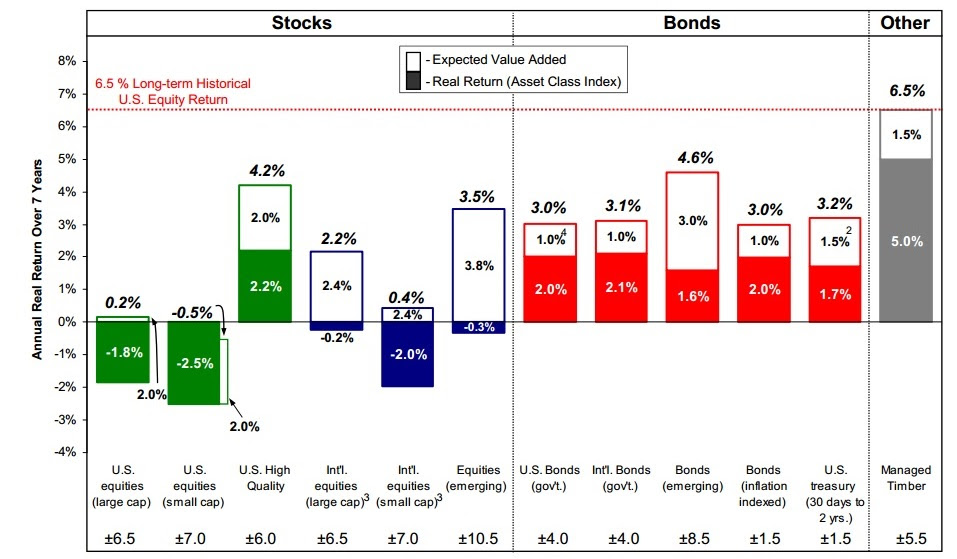Mr. Grantham's dour outlook was not in tune with what was actually happening in the markets and didn't really reflect our views.
So instead we've taken to linking to his commentaries where oddly enough Mr. G, got exuberantly - and correctly - bullish a few years ago and we have been leaning toward his original melt-up target of S&P 3300 as a blow off top. He hedged a bit in conversation with The Economist April 10 but said there was still a 40% possibility. "An update from Jeremy Grantham"
See special note after the jump.
First up, the April forecast via Advisor Perspectives, 17April:
GMO's 7-Year Asset Class Forecasts Still Favor Non-US Markets
The GMO Asset Allocation team has released its latest 7-Year Asset Class Forecasts.
Most global equity markets declined in the first quarter despite the corporate sector generally reporting reasonable fundamental data. As a result, GMO's 7-year equity forecasts mostly improved over the first quarter (see chart below). Even with these improvements, International and U.S. equities are still forecast to have flat to negative real returns over the next 7 years, with Emerging equities remaining an exception, forecast to have a positive real return of 1.9%.
"To us, the opportunity set for equity investors looks pretty clear: favor non-U.S. markets, especially value stocks in emerging markets," says GMO Asset Allocation team member John Thorndike. "Additionally, with the Fed continuing to raise short-term interest rates and the potential inflationary effects of tariffs and trade wars, we think investors are well served to keep their duration short."

....MORE
And the reason for checking in, from Barron's, July 19:
EM, Cash May Be Best Spots for the Next 7 Years, Says GMO
GMO has favored emerging markets for a while, but it's an area investors are fleeing. Capital Economics wrote in a note this morning that its capital flows tracker suggests an acceleration in money leaving emerging markets, with an estimated $40 billion leaving in June versus $10 billion in May–marking the highest level in 18 months. "The most plausible explanation for this is that the escalation of trade tensions between China and the U.S., and concerns about knock-on effects on other emerging markets via manufacturing supply chains, caused outflows to pick up," the economists wrote.Some stuff to keep in mind when evaluating GMO's public calls:
Investors watch flows in and out of emerging markets carefully because money flowing in helps fund spending in those countries, and are a major factor for markets. One concern that has loomed over emerging markets is the impact of the Federal Reserve raising rates, which have contributed to sharp declines in some currencies such as the Turkish lira and Brazilian real.
The one currency investors are watching especially closely is China's renminbi, which has been weakening in recent months. In 2015, a decline in the currency contributed to a sharp increase in capital outflows, but Capital Economics says a repeat is unlikely because officials' tolerance for a weaker currency will only go so far. Capital Economics writes that even if overall emerging-market capital outflows accelerate further, most countries are well placed to withstand the hit because of stronger fiscal health than in the past–with perhaps the exception of Turkey and Argentina.
But that's not to say the volatility will go away. BBH currency strategist Marc Chandler told Barron's this morning that while values are being uncovered in the emerging markets, it may be too early to pick a bottom since the Federal Reserve is likely to continue raising rates....MORE
Feb 2010
"Grantham’s ‘Horrifically Early’ Calls Challenge GMO"
March 2014
How Good Is Jeremy Grantham's Forecasting Record?
His strong pessimism drives GMO managed funds toward the most stable (large capitalization) value stocks, and these funds have performed fairly well (reflecting perhaps a value premium rather than market timing).
See also:
GMO 7-Year Asset Class Real Return Forecasts: 2007

From James Montier’s GMO Quarterly Letter, July 2013, titled The Purgatory of Low Returns, download the full PDF here (registration may be required).
GMO 7-Year Asset Class Forecasts - June 2012
Grantham Mayo 7-year Asset Class Real Return Forecast June 30, 2013
Grantham, Mayo, Van Otterloo's 7-Year Asset Class Performance Forecast April 24, 2015
And Sept. 2009
Jeremy Grantham: "GMO’s 7-Year Asset Class Return Forecast"